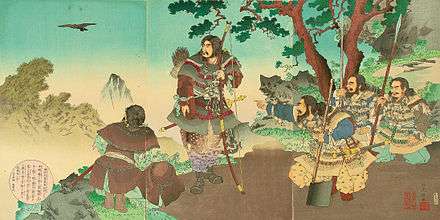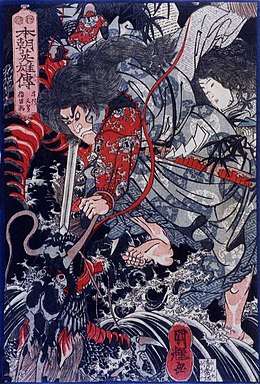Three-legged crow
The three-legged (or tripedal) crow (simplified Chinese: 三足乌; traditional Chinese: 三足烏; pinyin: sān zú wū) is a creature found in various mythologies and arts of East Asia.[1] It is believed by East Asian cultures to inhabit and represent the Sun.


It has also been found figured on ancient coins from Lycia and Pamphylia.[1]
The earliest forms of the tripedal crow have been found in China. Evidence of the earliest bird-Sun motif or totemic articles excavated around 5000 B.C. from the lower Yangtze River delta area. This bird-Sun totem heritage was observed in later Yangshao and Longshan cultures.[2] The Chinese have several versions of crow and crow-Sun tales. But the most popular depiction and myth of the Sun crow is that of the Yangwu or Jinwu, the "golden crow".[3]
China
In Chinese mythology and culture, the three-legged crow is called the sanzuwu (simplified Chinese: 三足乌; traditional Chinese: 三足烏; pinyin: sān zú wū; Cantonese: sam1zuk1wu1; Shanghainese: sae tsoh u) and is present in many myths. It is also mentioned in the Shanhaijing. The earliest known depiction of a three-legged crow appears in Neolithic pottery of the Yangshao culture.[4] The sanzuwu is also of the Twelve Medallions that is used in the decoration of formal imperial garments in ancient China.
Sun crow in Chinese mythology


The most popular depiction and myth of a sanzuwu is that of a sun crow called the Yangwu (陽烏; yángwū) or more commonly referred to as the Jīnwū (金烏; jīnwū) or "golden crow". Even though it is described as a crow or raven, it is usually colored red instead of black.[6] A silk painting from the Western Han excavated at the Mawangdui archaeological site also depicts a "golden crow" in the sun.[5]
According to folklore, there were originally ten sun crows which settled in 10 separate suns. They perched on a red mulberry tree called the Fusang (扶桑; fúsāng), literally meaning "the leaning mulberry tree", in the East at the foot of the Valley of the Sun. This mulberry tree was said to have many mouths opening from its branches.[7] Each day one of the sun crows would be rostered to travel around the world on a carriage, driven by Xihe, the 'mother' of the suns. As soon as one sun crow returned, another one would set forth in its journey crossing the sky. According to Shanhaijing, the sun crows loved eating two grasses of immortality, one called the Diri (地日; dìrì), or "ground sun", and the other the Chunsheng (春生; chūnshēng), or "spring grow". The sun crows would often descend from heaven on to the earth and feast on these grasses, but Xihe did not like this; thus, she covered their eyes to prevent them from doing so.[8] Folklore also held that, at around 2170 BC, all ten sun crows came out on the same day, causing the world to burn; Houyi, the celestial archer saved the day by shooting down all but one of the sun crows. (See Mid-Autumn Festival for variants of this legend.)
Other tripedal creatures in Chinese mythology
In Chinese mythology, there are other three-legged creatures besides the crow, for instance, the yu 魊 "a three-legged tortoise that causes malaria".[9] The three-legged crow symbolizing the sun has a yin yang counterpart in the chánchú 蟾蜍 "three-legged toad" symbolizing the moon (along with the moon rabbit). According to an ancient tradition, this toad is the transformed Chang'e lunar deity who stole the elixir of life from her husband Houyi the archer, and fled to the moon where she was turned into a toad.[10] The Fènghuáng is commonly depicted as being two-legged but there are some instances in art in which it has a three-legged appearance.[11][12] Xi Wangmu (Queen Mother of the West) is also said to have three green birds (青鳥; qīngniǎo) that gathered food for her and in Han-period religious art they were depicted as having three legs.[13][14] In the Yongtai Tomb dating to the Tang Dynasty Era, when the Cult of Xi Wangu flourished, the birds are also shown as being three-legged.[15]
Japan

In Japanese mythology, this flying creature is a raven or a jungle crow called Yatagarasu (八咫烏, "eight-span crow")[16] and the appearance of the great bird is construed as evidence of the will of Heaven or divine intervention in human affairs.[17]
Although Yatagarasu is mentioned in a number of places in Shintō, the depictions are primarily seen on Edo wood art, dating back to the early 1800s wood-art era. Although not as celebrated today, the crow is a mark of rebirth and rejuvenation; the animal that has historically cleaned up after great battles symbolized the renaissance after such tragedy.
Yatagarasu as a crow-god is a symbol specifically of guidance. This great crow was sent from heaven as a guide for Emperor Jimmu on his initial journey from the region which would become Kumano to what would become Yamato, (Yoshino and then Kashihara). It is generally accepted that Yatagarasu is an incarnation of Taketsunimi no mikoto, but none of the early surviving documentary records are quite so specific.[18]
In more than one instance, Yatagarasu appears as a three legged crow not in Kojiki but in Wamyō Ruijushō.
Both the Japan Football Association and subsequently its administered teams such as the Japan national football team use the symbol of Yatagarasu in their emblems and badges respectively.[19] The winner of the Emperor's Cup is also given the honor of wearing the Yatagarasu emblem the following season.
Although the Yatagarasu is commonly perceived as a three-legged crow, there is in fact no mention of it being such in the original Kojiki. Consequently, it is theorised that this is a result of a later possible misinterpretation during the Heian period that the Yatagarasu and the Chinese Yangwu refer to an identical entity.
Korea

In Korean mythology, it is known as Samjogo (hangul: 삼족오; hanja: 三足烏). During the period of the Goguryo kingdom, the Samjok-o was considered a symbol of the sun. The ancient Goguryo people thought that a three-legged crow lived in the sun while a turtle lived in the moon. Samjok-o was a highly regarded symbol of power, thought superior to both the dragon and the Korean bonghwang.
Although the Samjok-o is mainly considered the symbol of Goguryeo, it is also found in Goryeo and Joseon dynasty.
Samjoko was appeared in a story <YeonorangSeonyeo>, about Yeono and Seo couple, who lived on the beach of the East Sea in 157 (King Adalala 4), rode to Japan on a moving rock. The Japanese took two people to Japan as kings and noblemen. At that time, the light of the sun and the moon disappeared in Silla, and the official who looked and said that the sun and the moon were in Silla and went to Japan. King Adalala sent an official to Japan to return to the Yeono and Seo couple, but Yeono said that take the silk that made by his wife, Seo, and sacrifice it to the sky. As he said, the sun and moon were brighter again. [20]
In modern Korea, Samjok-o is still found especially in dramas such as Jumong. The three-legged crow was one of several emblems under consideration to replace the bonghwang in the Korean seal of state when its revision was considered in 2008.[21] The Samjok-o appears also in Jeonbuk Hyundai Motors FC's current emblem. There are some Korean companies using Samjok-o as their corporate logos.
See also
References
Citations
- Volker, T. (1975). The Animal in Far Eastern Art and Especially in the Art of the Japanese. Brill. p. 39.
- Chinese Prehistory
- Yatagrarasu: The three-legged crow and its possible origins
- Allan, Sarah (1991), The shape of the turtle: myth, art, and cosmos in early China, SUNY Press, p. 31, ISBN 0-7914-0460-9
- "T-shaped painting on silk from Xin Zhui's tomb". Hunan Museum.
- Katherine M. Ball (2004). Animal motifs in Asian art: an illustrated guide to their meanings and aesthetics. Courier Dover Publications. p. 241. ISBN 978-0-486-43338-7.
- Allan 1991, p. 27
- Lihui Yang; Deming An; Jessica Anderson Turner (2005). Handbook of Chinese mythology. ABC-CLIO. pp. 95–96. ISBN 978-1-57607-806-8.
- Wolfram Eberhard (1968), The Local Cultures of South and East China, E.J. Brill, 193-195.
- Wolfram Eberhard (1986), A Dictionary of Chinese Symbols: Hidden Symbols in Chinese Life and Thought, Routledge, 292.
- Feng Huang, Emperor of Birds
- Ancient Spiral: The Phoenix Archived 2008-05-17 at the Wayback Machine
- Richard E. Strassberg (2002). A Chinese bestiary: strange creatures from the guideways through mountains and seas. University of California Press. p. 195. ISBN 978-0-520-21844-4.
- Xi Wangmu Summary
- China 1999 - Tang Dynasty Day
- Ponsonby-Fane (1953), pp. 143-152
- Ponsonby-Fane (1963), p. 11
- Ponsonby-Fane (1953), p. 147
- Organisation|JFA|Japan Football Association
- "삼족오". 한국민속대백과사전.
- "Three-Legged Bird to Replace Phoenix on State Seal," Archived 2006-01-18 at the Wayback Machine Chosun Ilbo (Seoul). January 16, 2006.
Sources
- Ponsonby-Fane, Richard Arthur Brabazon (1953). Studies in Shintō and Shrines: Papers Selected from the Works of the Late R.A.B. Ponsonby-Fane, LL. D. Dr. Richard Ponsonby-Fane Series. 1. Kyoto: Ponsonby Memorial Society. OCLC 374884.CS1 maint: ref=harv (link)
- Ponsonby-Fane, Richard Arthur Brabazon (1963). The Vicissitudes of Shinto. Dr. Richard Ponsonby Fane Series. 5. Kyoto: Ponsonby Memorial Society. OCLC 36655.CS1 maint: ref=harv (link)

